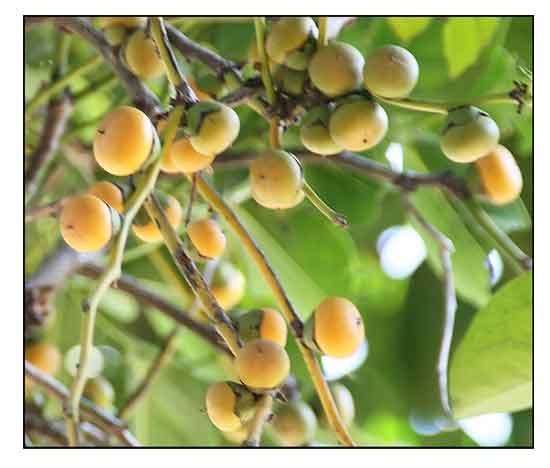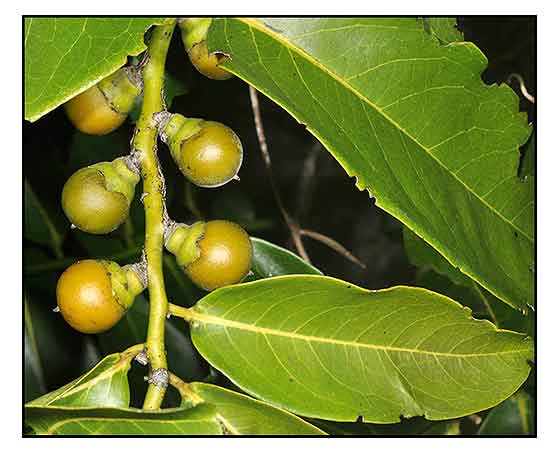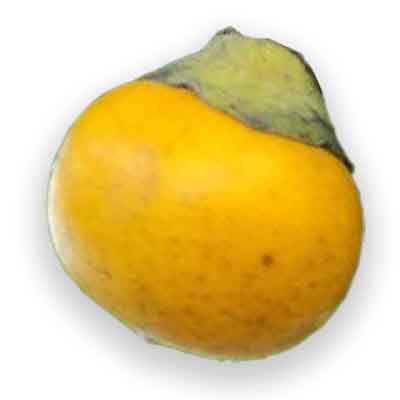 Gen info Gen info
- Diospyros is a genus of over 700 species of deciduous and evergreen trees and shrubs. The majority are in the tropics. The Royal Botanic Gardens, Kew, list over 1000 species, with about 700 assigned with confidence. The oldest fossils of the genus date to the Eocene, the Tertiary period between Paleocene and Oligocene epochs. (3)
-
Etymology: The genus name Diospyros derives from the Greek words dios and pyros, the Greek name literally meaning Zeus's wheat", or more generally, "divine food" or "divine fruit".Specific epithet maritima means "by the sea", referring to its coastal habit. (3)
Botany
Diospyros maritima is a tree 3--12 m tall, evergreen. Young shoots yellowish brown, glabrous. Winter buds sericeous. Petiole ca. 1 cm; leaf blade oblong-elliptic to lanceolate-oblong, 7--17 X 3--8 cm, leathery, glabrous except sometimes for pubescent abaxial surface when young, ± concolorous, base obtuse to somewhat attenuate and with 2(--4) gland patches near petiole, apex obtusely acuminate, lateral veins ca. 7 per side, reticulate veinlets slender and inconspicuous. Inflorescences bracteate at base. Male flowers in 2- or 3-flowered cymes; pedicels short and thick; calyx ca. 3.5 mm, densely sericeous throughout; calyx lobes 4, triangular, slightly longer than tube; corolla urn-shaped, ca. 1.6 cm; corolla tube ca. 9 mm, outside densely appressed hairy; corolla lobes 3 or 4, oblong, ca. 7 X 4 mm, outside with right half densely sericeous, otherwise subglabrous, apex rounded; stamens 16; filaments hirsute; pistillode hirsute. Female flowers solitary, sessile; calyx lobes 4, both surfaces sericeous; corolla outside sericeous, inside glabrous; staminodes present; ovary 8-locular, rusty hairy. Fruiting calyx ca. 2 cm in diam.; lobes 4, poorly defined, reflexed. Berries orange-colored, depressed globose, 1.5--3 cm in diam., 8-locular, glabrous when ripe except for base of style. (Flora of China)
Distribution
- Native to the Philippines.
- Also native to Australia, Borneo, Cambodia, China,
Jawa, Laos, Lesser Sunda Is., Maluku, Nansei-Shoto, New Guinea, Solomon Is., Sulawesi, Sumatera, Taiwan, Vietnam. (1)
- Habitat is coastal forests.
 Constituents Constituents
- Bioactivity-directed fractionation of two bark samples of Diospyros maritima yielded a diverse set of secondary metabolites. Naphthoquinone plumbagin (1) was found in both specimens. The first sample also yielded a series of plumbagin dimers, maritinone (2), chitranone (3), and zeylanone (4). The second sample yielded a new naphthoquinone derivative, (4S)-shinanolone (5), a new natural product coumariin, 7,8-dimethoxy-6-hydroxycoumarin (6), along with three other analogues of plumbagin,
2-methoxy-7-nethyljuglone (7), 3-methoxy-7-methyljuglone (8), and 7-methyljuglone (9). (see study below) (4)
- Study of stem isolated three new lupane derivatives,
3-(E)-feruloyl-28-palmitoylbetulin (1), 3-(Z)-coumaroyl-28-palmitoylbetulin (2), and 3-(Z)-coumaroyllupeol (3). (6)
- Study of n-hexane extract of stems isolated one novel coumaric acid ester of lupeol, dioslupecin A (1), three naphthoquinones, 8'-hydroxyisodiospyrin (2), isodiospyrin (3), and plumbagin (4), three triterpenes, lupeol, lupenone, and taraxerone, and four sterols, ß-sitosterol, stigmasterol, stigmast-4-en-3-one and ergosta-4,6,8(14),22--tetraen-3-one. The compounds were evaluated for in vitro cytotoxicity in 4 cancer cell lines. (see study below) (7)
- Study of fresh fruits isolated three new naphthoquinones, 3-bromoplumbagin (1), ethylidene-6, 6'-biplumbagin (2), and 3-(2-hydroxyethyl)plumbagin (3), were isolated, in addition to six known naphthoquinones, 3-chloroplumbagin (4), 3-methylplumbagin (5), plumbagin (6), droserone (7), elliptinone (8), and maritinone (9). (11)
- Study of fruits isolated three new naphthoquine derivatives, 6-(1-ethoxyethyl)plumbagin (16), ethylidene-3,3′-biplumbagin (17), and ethylidene-3,6′-biplumbagin (18), were isolated, in addition to six known naphthoquinones, isozeylanone (10), 3,3′-biplumbagin (11), chitranone (12), methylene-3,3′-biplumbagin (13), 2,3-epoxyplumbagin (14), and 3,8′-biplumbagin (15). (see study below) (12)
- Study of leaves isolated eight new glycosides, diosmariosides A-H.(see study below) (13)
- Study of 1-BuOH-soluble fraction of methanol extract of D. maritima isolated three new oleanane-type and one new ursane-type triterpene glucoside, named ebenamariosides A-D (1-4), along with two megastigmanes.
(14)
 Properties Properties
- Bark from sap is concentrated and may cause severe itching and inflammation. (10)
-
Studies have suggested antibacterial, cytotoxicity, anticancer, analgesic, anti-inflammatory, ichthoyotoxic properties.
Parts used
Leaves, aerial parts.
Uses
Edibility
- Fruit is edible.
- An excellent source of fiber, vitamin A and C, and omega-3 fatty acids.
Folkloric
- No reported folkloric medicinal use in the Philippines.
-
In Taiwan, stems used for treatment of rheumatic diseases. (5)
Others
- Fish poison: Used as fish poison in Vietnam.
Studies
• Cytotoxic / Antibacterial / Bark: Bioactivity-directed fractionation of two bark samples of Diospyros maritima yielded a diverse set of secondary metabolites. The isolates were evaluated for cytotoxicity and antimicrobial activity. (see constituents above) (4)
• Phenolic and Aliphatic Lactone: A previous study reported new naphthoquinones and triterpenoids. The naphthoquinones exhibited strong antitumor activity. This study isolated two new compounds from the same fraction: 3-ethoxy-1-(4-hydroxy-3-methoxyphenyl)-1-propanone (1) and maritolide (2). (5)
• Cytotoxicity / Stems: Study of n-hexane extract of stems isolated one novel coumaric acid ester of lupeol, dioslupecin A (1), three naphthoquinones, 8'-hydroxyisodiospyrin (2), isodiospyrin (3), and plumbagin (4), three triterpenes, lupeol, lupenone, and taraxerone, and four sterols, ß-sitosterol, stigmasterol, stigmast-4-en-3-one and ergosta-4,6,8(14),22--tetraen-3-one. The compounds were evaluated for in vitro cytotoxicity in 4 cancer cell lines. Compound 2 showed similar cytotoxicity against hepatoma, nasopharynx carcinoma, colon carcinoma, and cervical carcinoma. Compounds 3 and 4exhibited strong cytotoxicity against HEPA-3B, KB, COLO-205 and HELA. (7)
• Analgesic / Anti-Inflammatory: Study evaluated the analgesic effects of taraxeren-3-one from D. maritima, using models of acetic acid-induced writhing response and formalin test, and anti-inflammatory effects using carrageenan-induced paw edema model. Results showed anti-inflammatory and analgesic effects. The anti-inflammatory mechanisms may be related to a decrease in level of MDA in the edema paw via increased activities of SOD, CAT, GPx, and GSH in the liver. Also, taraxeren-3-one could affect production of NO and TNF-α. (8)
• Silver Nanoparticles / Leaves: Study reports on the eco-friendly and cost-effective biological synthesis of silver nanoparticles (AgNPs) using leaves of D. maritma. The leaves extract contained phenols, flavonoids, saponins, and alkaloids, which may act as reducing agent. (9)
• Plumbagin / Antibacterial / Bark: Study isolated plumbagin (1,4-naphthalenedione-5-hydroxy-2-methyl) from the bark of D. maritima. The compound was tested for antibacterial activity by paper disk diffusion on double-layer agar medium. The pure compound inhibited Staphylococcus aureus and Aeromonas hydrophila with MICs of 0.625 and 5.0 µg/mL, respectively. (10)
• Naphthoquinone Derivatives / Ichthyotoxic Activity / Fruits: Study of fruits isolated three new naphthoquinone derivatives, 6-(1-ethoxyethyl)plumbagin (16), ethylidene-3,3′-biplumbagin (17), and ethylidene-3,6′-biplumbagin (18), were isolated, in addition to six known naphthoquinones, isozeylanone (10), 3,3′-biplumbagin (11), chitranone (12), methylene-3,3′-biplumbagin (13), 2,3-epoxyplumbagin (14), and 3,8′-biplumbagin (15). Quinones 11, 12, and 14-16 showed strong ichthyotoxic activity and quinone 14 showed mild germination inhibitory activity. (12)
• Diosmarioside / Cytotoxicity / Adenocarcinoma (A549) Cell Liane / Leaves: Study of leaves isolated eight new glycosides, diosmariosides A-H. Among the compounds, only diosmarioside D (4) and sugeroside 9 showed strong cytotoxic activity towards lung adenocarcinoma (A549) cell line. (13 )
Availability
Wild-crafted. |

![]()





 Properties
Properties